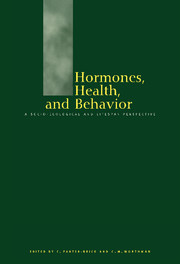Book contents
- Frontmatter
- Contents
- Contributors
- 1 Contributions of biological anthropology to the study of hormones, health, and behavior
- 2 Hormonal correlates of personality and social contexts: from non-human to human primates
- 3 Epidemiology of human development
- 4 Family environment, stress, and health during childhood
- 5 Work and hormonal variation in subsistence and industrial contexts
- 6 Reproductive ecology and reproductive cancers
- 7 Diet, hormones, and health: an evolutionary–ecological perspective
- 8 Modernization, psychosocial factors, insulin, and cardiovascular health
- Index
6 - Reproductive ecology and reproductive cancers
Published online by Cambridge University Press: 29 January 2010
- Frontmatter
- Contents
- Contributors
- 1 Contributions of biological anthropology to the study of hormones, health, and behavior
- 2 Hormonal correlates of personality and social contexts: from non-human to human primates
- 3 Epidemiology of human development
- 4 Family environment, stress, and health during childhood
- 5 Work and hormonal variation in subsistence and industrial contexts
- 6 Reproductive ecology and reproductive cancers
- 7 Diet, hormones, and health: an evolutionary–ecological perspective
- 8 Modernization, psychosocial factors, insulin, and cardiovascular health
- Index
Summary
Introduction
The study of human reproductive ecology has in recent years greatly expanded our appreciation of the natural variability of human reproductive physiology. In particular, gonadal function in both males and females has been shown to occur along a broad continuum of variation, both within and between individuals and between populations. Furthermore, such variation has been shown to be interpretable as a healthy, adaptive response to ecological conditions (Ellison et al., 1993a; Ellison 1994, 1995). In keeping with the broader perspective of Darwinian medicine (Ewald, 1980; Nesse & Williams, 1994), the perspective of reproductive ecology has entailed making a distinction between adaptive responses to stressful situations and the etiology of those situations themselves. Under energetic stress, for example, it may be advantageous for ovarian function to be suppressed. That does not mean that energetic stress itself is advantageous. Seeking to treat suppressed ovarian function under these conditions as if it were a pathology, rather than seeking to relieve the energetic stress, would imply a basic misunderstanding of the problem, its etiology, and its appropriate treatment. It is only recently, for example, that clinicians have begun to realize that the amenorrhea associated with athletic activity in many women is not itself a pathology to be rectified by “driving” cycles of endometrial maturation with exogenous steroids.
- Type
- Chapter
- Information
- Hormones, Health and BehaviourA Socio-ecological and Lifespan Perspective, pp. 184 - 209Publisher: Cambridge University PressPrint publication year: 1998
- 5
- Cited by

